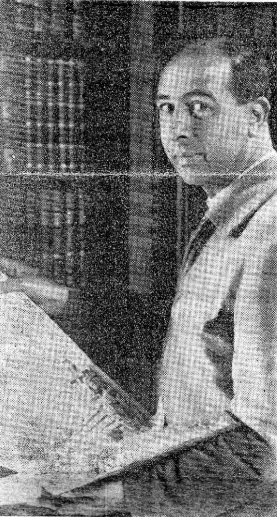PUT ONLINE 25.4.2024
La Dépêche du Midi, 7 November 1959
Written by someone who simply signed themselves “RL”.
The article mentions, for the very first time in print, the legend of the Shepherd Paris; however, the name “Ignace Paris” does not seem to have been known at the time.
Noël Corbu – an hotelier who's also an author – fills 800 pages that reveal all the secrets of the treasure of Blanche of Castille
Abbé Saunières [sic], the curé of Rennes-le-Château, has certainly been talked about a great deal in recent years. No doubt you'll be all too familiar with the legend that surrounds this ecclesiastic. Let's therefore simply recall that Saunières was suspected of having discovered, at the beginning of the 20th century, a fabulous treasure. This fortune had been lying undiscovered in an underground passage (or cavern) at Rennes-le-Château. It consisted, so it was said, of the treasure of Blanche of Castille, who sought to conceal it from the gaze of greedy intruders by burying it in this picturesque corner of the Aude in 1250. It was while he was engaged in some restoration work on his church that Saunières, who was active as a priest around 1910, found some documents identifying the hiding-place of a fortune that has been estimated at 12 tons of gold.
This story is however challenged by some commentators, who think it's just a fairy-tale. Others however advance proof of the treasure's existence by drawing attention to the extraordinary expenditure that Saunière engaged in until his death, and to his sumptuous lifestyle. The ambition of local hotelier and author Noël Corbu is to use documents of incontestable validity to reconstitute the story of Rennes-le-Château. Now the owner of the same property that Saunière himself once occupied, Corbu is a firm believer in the reality of the treasure-hoard.
And so, for some two years now, Corbu has been patiently assembling certain documents which, he claims, firmly support what others maintain is only a legend. He has access to Saunières' extensive correspondence. He also received certain confidences from Saunières' former maid, now dead. And he has rummaged through libraries in Paris, Toulouse, Narbonne and Carcassonne. The information he has gathered will form the subject of a major work (of some 800 pages) which he should complete next year. From this book we shall be able to learn about the history of the Comté of Razes [sic], of which Rennes-le-Château formed a part, and which was itself an ancient and powerful Gaulish oppidum. We shall also learn that the famous treasure of Blanche de Castille was in fact cursed: a shepherd who, in 1645, found it by chance, subsequently went mad, while Saunières himself died at the very moment when, having shaken off all the encumbrances of his life, he was finally in a position to enjoy his new-found wealth. Corbu's projected title for the work is La puissance et la mort, “Power and Death”.
“This book,” says Corbu, “will be even more gripping than the most exciting of detective novels...”
And Corbu knows what he's talking about, as he's already written three detective novels himself: Le mort cambrioleur, Police-party and Faute de fille, prends le môme!
RL
[Photo caption:]
Noël Corbu, the hotelier who's also an author, working on La puissance de la mort [sic: “The Power of Death”] in the sumptuous library assembled by Abbé Saunières.
Photo credit: La Dépêche/Marcel Loupiac.

|

